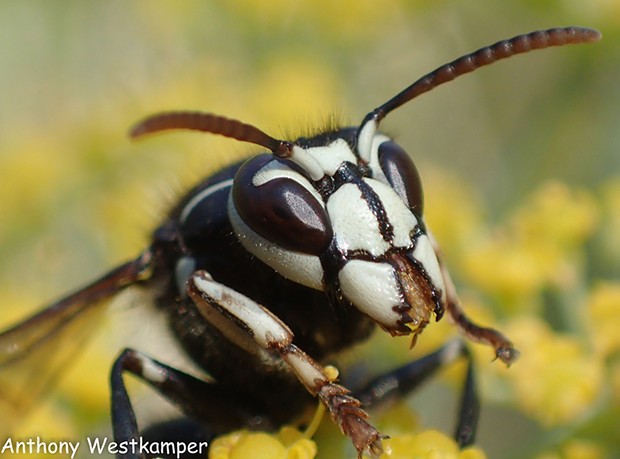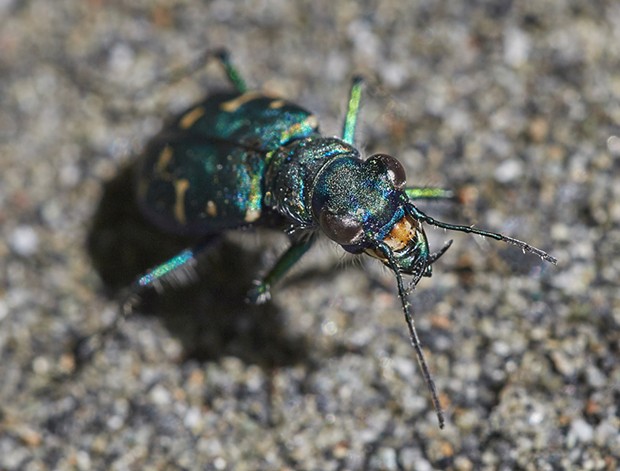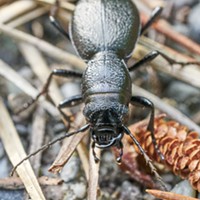[
{
"name": "Top Stories Video Pair",
"insertPoint": "7",
"component": "17087298",
"parentWrapperClass": "fdn-ads-inline-content-block",
"requiredCountToDisplay": "1"
}
]
The bald faced truth
I decided to devote this week's contribution to a single unpopular species. Known for its large size, aggressive behavior and powerful sting, the bald faced hornet (Dolichovespula maculata) is liked by few people. They're neither completely bald faced nor technically hornets. Their white faces are sparsely covered with setae (hairs) and they are, in fact, the largest member of the yellow jacket clade of wasps.
When I spotted one building a slender, gray stalactite from the ridge of my greenhouse, I knew it was preparing to build a nest. Instead of reaching for the wasp killer, I reached for a camera. I really wanted to find where she was gnawing the wood she ground into a pulp to build her nest. I was going to stain some paper with food coloring and try to get her to build a multi colored hive. Sadly, I never found the source of her building materials.
Over the next few days I visited often. Whenever I got too close, she let me know by facing me, putting her wings back in a "V" shape and vibrating them loudly. To quote an immigrant friend, "I love this country, even the snakes warn you." Not only does she sport black and (well almost) yellow aposematic coloration (conspicuous coloration or markings of an animal serving to warn off predators), but also what I've termed "aposematic sonification." Like a rattlesnake, she makes warning sounds.
They do have their good points. First and foremost, as good mothers, they are voracious hunters of other insects, including yellow jackets, which they chew up and feed to their young. A hornet or paper wasp nest near your garden can provide both a lot of pest protection and pollination services, as the adult workers feed largely on nectar.
She laid eggs in the first four cells she had built and then one day never returned. I suspect a bird probably got her. The eggs will never hatch and the nest will forever be unfinished.
If one starts to build her nest nearby and you spot it before the first generation of workers hatches, watch for her to leave to gather wood or feed herself, and knock it down. Then leave for a while. Most likely she will get the message and move on.
Beetles in the spring
While beetles were my first love when I started studying insects and are believed to have the greatest number of species of any of the insect orders, I find I seldom write about them.
Two years ago I wrote about the night stalking tiger beetle (Omus californicus), a nocturnal terror with a Darth Vader demeanor ("Darth Omus," May 4, 2017). That was the first one I'd ever seen, and I was impressed by its ferocious face. This year I've seen several, both at night and in the daytime. Like their cousins within the family Carabidae, they possess huge mandibles to subdue prey and with which the males hold onto their mates.
Unlike genus Omus, which are completely black, the locally common western tiger beetle (Cicindela oregona) comes in various hues, from a conservative faun gray to iridescent blue green. On close inspection even the somber hued ones have metallic undertones. You can find these on the sandy spaces along our local river bars. At about half an inch long, they run rapidly ahead of you and take wing, flying a short distance to get out of your way.
Read more of Anthony Westkamper's HumBug on Sundays at www.northcoastjournal.com.
Speaking of...
-
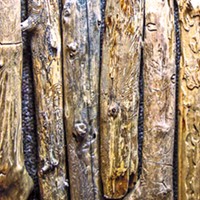
Wizard Sticks
Aug 10, 2023 -
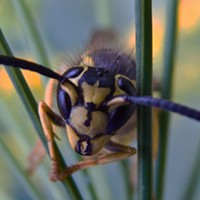
HumBug: Saps, Jumpers and Stingers
Mar 1, 2020 -
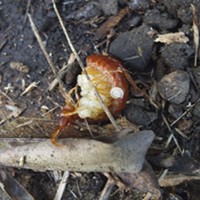
HumBug: Three for a Rainy Day
Jan 26, 2020 - More »
more from the author
-
HumBug: Early Spring Pollinators
- Apr 12, 2020
-
HumBug: A Recipe for History
- Apr 5, 2020
-
HumBug: Bugs in the City
- Mar 29, 2020
- More »
